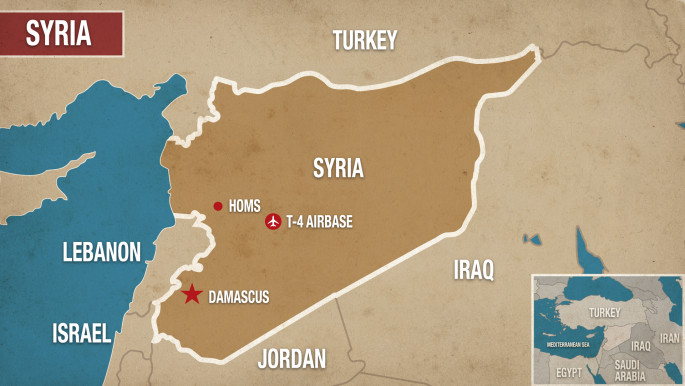Russian warplanes 'drop napalm on Homs countryside villages'
Russian warplanes continue their relentless, indiscriminate bombardment of rebel-held areas in Syria, using internationally banned munitions.
2 min read
Footage of the attack surfaced on social media shortly after [Video grab/Twitter]
Russian warplanes continue their relentless, indiscriminate bombardment of rebel-held areas in Syria, using internationally banned munitions.
On Friday night, Russian planes reportedly deployed what appears to be napalm and incendiary bombs into the northern Homs countryside, central Syria.
"Napalm bombs were again dropped on the town of Rastan, and villages...in the nothern countyside," the rebel-sympathetic Homs Media Centre told The New Arab.
The sources said there were two raids, dropping napalm and phosphorus bombs, and causing a huge blaze in the town.
No casualties were reported.
It is difficult to independently verify the type of munitions used in the Syrian battlefield, however Russian and Syrian regime use of "napalm-like" bombs has been documented in the past.
In August, Human Rights Watch said the joint Syrian-Russian military operation has been using incendiary weapons, "which burn their victims and start fires, in civilian areas of Syria in violation of international law.
Past use
"Incendiary weapons have been used at least 18 times over the past nine weeks, including in attacks on the opposition-held areas in the cities of Aleppo and Idlib on August 7, 2016," said the detailed HRW investigation at the time.
The first attack using napalm-like substances may have taken place in August 2012, a year after the uprising began, in Orum al-Kubra and al-Atarib, towns in the Aleppo countryside.
Thirty-eight people were killed in Orum al-Kubra, according to the Centre for the Documentation of Violations in Syria.
On Friday night, Russian planes reportedly deployed what appears to be napalm and incendiary bombs into the northern Homs countryside, central Syria.
"Napalm bombs were again dropped on the town of Rastan, and villages...in the nothern countyside," the rebel-sympathetic Homs Media Centre told The New Arab.
The sources said there were two raids, dropping napalm and phosphorus bombs, and causing a huge blaze in the town.
No casualties were reported.
It is difficult to independently verify the type of munitions used in the Syrian battlefield, however Russian and Syrian regime use of "napalm-like" bombs has been documented in the past.
In August, Human Rights Watch said the joint Syrian-Russian military operation has been using incendiary weapons, "which burn their victims and start fires, in civilian areas of Syria in violation of international law.
Past use
 |
The first attack using napalm-like substances may have taken place in August 2012, a year after the uprising began, in Orum al-Kubra and al-Atarib, towns in the Aleppo countryside.
Thirty-eight people were killed in Orum al-Kubra, according to the Centre for the Documentation of Violations in Syria.
Napalm is an flammable liquid used in warfare. It is a mixture of a gelling agent, and either petroleum or a similar fuel. It was initially used as an incendiary device against buildings and later primarily as an anti-personnel weapon, as it sticks to skin and causes severe burns when on fire.
Russia is a party to the incendiary weapons protocol that prohibits the use of these weapons in civilian areas. The Syrian regime never signed the protocol.
Twitter Post
|
Al-Araby al-Jadeed's Anas al-Kurdi contributed to this report.





 Follow the Middle East's top stories in English at The New Arab on Google News
Follow the Middle East's top stories in English at The New Arab on Google News
![Israeli forces ordered bombed Gaza's Jabalia, ordering residents to leave [Getty]](/sites/default/files/styles/image_330x185/public/2176418030.jpeg?h=a5f2f23a&itok=_YGZaP1z)

